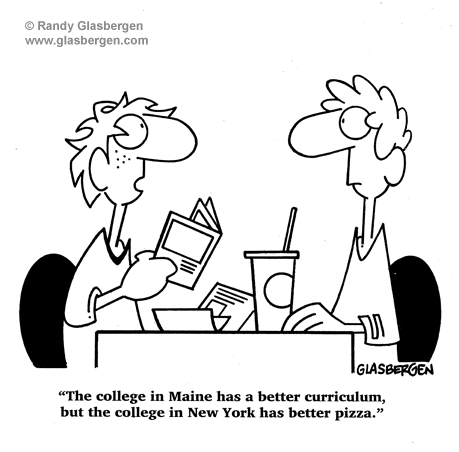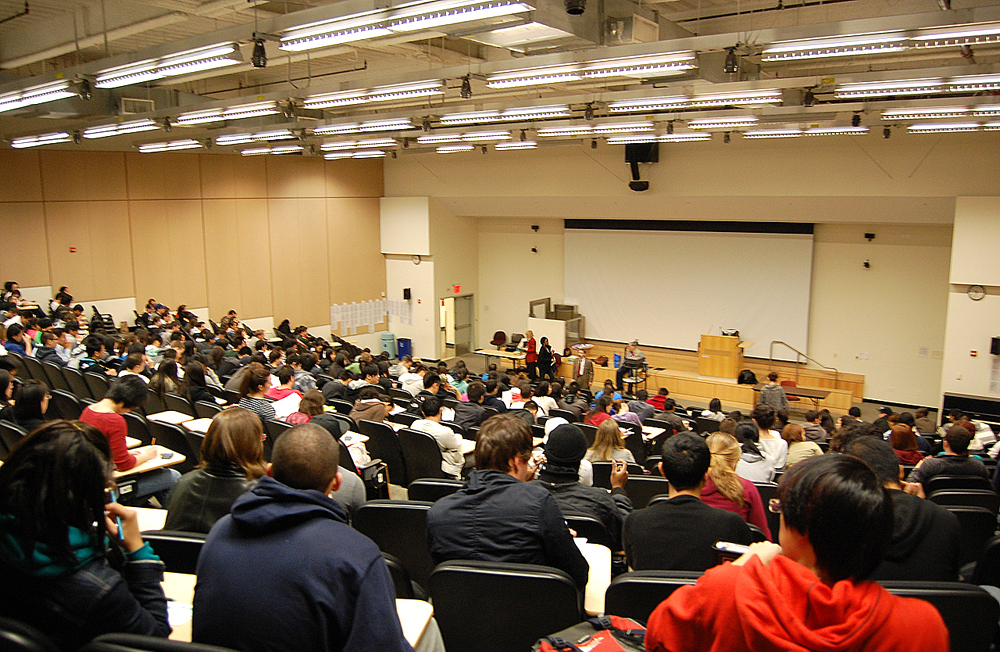"The majority of Arizona high-school graduates’ scores on two popular college-admissions tests — the ACT and the SAT — indicate that the students are ill-prepared for college and would likely need to take remedial classes once there, according to reports from the groups responsible for administering the tests.
Of the more than 31,000 Arizona high-school seniors who took the ACT last year, only 21 percent stand a strong chance of earning a C or higher in first-year college courses related to math, science, English and reading, according to one report."
Karen Schmidt.
Reading, writing, and 'rithmetic--the three basics that have been the foundation of our education. All three have been affected in interesting ways with the advent of technology. I will leave the math instructors to address the impact of calculators and computerized math programs on their field. We college English instructors are dealing with the impact of the Internet and technology upon reading and writing. Yes, students are actually reading and writing more than was predicted at the advent of the technology. However, the nature of both has changed drastically. We saw this in the essays written for our composition classes for several years. When texting first became available through the number pads on those old cell phones, we read many essays using "i", "cuz", and many other abbreviated words. I still have a copy of an email that I had trouble deciphering because of the text-speak used. The development of those small keyboards helped because most students returned to typing whole sentences instead of chopped up phrases. Now smart phones automatically capitalize the first letter after a period for those people who can't be bothered or, in the case of some of our students, may not know that is how you begin the next sentence. Student writing is also impacted by the fact that texting and Facebook encourage short messages. As a result, students facing academic discourse must adjust to writing longer "text" that reflects more complex thinking. This only comes with practice, practice, practice--something most of our students have not had enough of when they enter our classrooms.
What has affected writing has also affected reading. Students are not accustomed to reading longer text. Since their technological world is adapted for short, quick reads, they are losing the attention span for sustained reading of longer paragraphs and multiple pages of text. And they assume that the reading skills they use for the Internet and texting are sufficient for academic text. As a reading instructor, my main learning outcome for students beyond the stated learning outcomes of my courses is to strengthen this attention span for longer interaction with text. Because of this, I want to use books and readings that will grab the attention of my students. If I can get them to re-discover the joy of reading, I can reach that outcome. Thus, I must be very careful about the material I choose.
I am always looking for new books to use in my reading classes that will engage my students in ways that will prepare them for this sustained attention. For ENG 082 and 083, I have to be very careful about the reading level because I want the book to challenge the students without discouraging them. Thus, I seek out books that they will find interesting and approachable. Once I find a book, I design my assignments to encourage students to become active readers.

One book I have used is
October Sky by Homer Hickham, a great selection because his memoir focuses on his high school experiences--some humorous, some sad, some inspirational, and some touching. Every student can compare his or her teenage years to Hickham's. Because of this, I have been able to design the reading responses to be both personal and interactive with each new section of the reading. Rather than asking short answer questions about content, I ask students to write two detailed paragraphs. In the first paragraph, they give their reactions to the reading: Was anything surprising or unexpected? Did they find the section boring or interesting? For the second paragraph, I have them interact with content specific within the chapters. Sometimes they are asked to compare their experience to Hickham's. Other times, they might compare their education to that of the 1950s. This allows them to bring in their own knowledge and experience while showing me that they indeed read the assignment.

A book I am using for the first time this semester is
Havana Real by Yoani Sanchez, an award-winning blogger out of Cuba. My motivation for this choice came from reading
Generation on a Tightrope by Arthur Levine, et al. In this compilation of survey and interview results from current college students, the authors conclude that this generation is globally more aware but internationally ignorant. When I found
Havana Real, I was attracted to the short, personal blogs of a woman who chose to return to Cuba in hopes of bringing about change. The added benefit is that she is still actively
blogging whenever she can, so my students can read what she is currently posting. Through Sanchez, I and my students are learning about daily life in a Communist country while making a personal connection to the author. My students can view the inside of a country that they have only known before through history books. With the added benefit of technology, students can also view YouTube videos of Sanchez, read blogs by other Cubans, and research Cuba with the motivation to learn personally. And they are being challenged by the courage and audacity of this woman, and her fellow bloggers, who dares to speak across the Internet. As a result, not only are my students getting hooked on active reading and proactive research, they are also becoming more aware of the ordinary people living in other countries. As with
October Sky, the reading responses ask for personal interaction with the text and critical thinking about the content.
I tell my student throughout the semester three important results from active, habitual reading, the kind in which the student becomes immersed in our written language:
- The more you read, the better you read. I am convinced this is why most of my students test into ENG 082 or 083. Our culture does not encourage reading for pleasure. Most students will confess to their loss of reading pleasure around seventh or eighth grade. Part of this is the educational shift in these grades to more non-fiction such as textbooks; part of this is because this is when the students' lives get filled with other time options such as sports, video games, etc.
- The more you read, the better you write. This was the conclusion of my research for my Masters degree. The premise is that fluency in any language requires immersion in the culture. Students who learn a language through grammar drills, test really well, but lack fluency in speaking. Students who are immersed in the language, usually by moving to the country, speak fluently even though they may not test well on specific grammar functions. This same principle holds true for reading and writing. The more students immerse themselves in our written language through reading, the more fluently they will be able to express their ideas through writing. Thus, trying to teach students to write better without having them read will be a very slow learning process. This is why some colleges are now moving toward combining developmental reading and writing into one course.
- The more your read, the better you think. We humans are wired to interact in very interesting ways with words on a page. This activity actually develops our ability to think critically, even from childhood. For example, in Endangered Minds: Why Children Don't Think and What We Can Do About It by Dr. Jane Healy, a chapter discusses the importance of reading for children. Reading stories during a certain age range promotes imaginary thinking, a stage which is vital to later development of critical thinking. If children watch the movie (Thank you, Disney!) instead of having the book read to them, this imaginary thinking is not developed in the same way in the brain. But all is not lost if a child is never read to, as long as that child develops into an avid reader later.
None of this comes from the passive activity of the eye tracking words across a page. Yet how many of our students think that this is all that is necessary to get those reading assignments done?
Reading, writing, and 'rithmetic: 12+ years of education to prepare students for college. Technology has changed the lives and habits of our students, but it does not prepare them for the expectations of college learning. Many are shocked to discover how much of college learning is expected to take place within the pages of written text. They will continue to balk at the reading until they become engaged in the subject and until they can sustain the attention for longer texts.
"According to a similar annual report on the SAT, Arizona high-school seniors who took the test last year scored an average of 1498 — below the benchmark of 1550 that predicts students will achieve grades of a B- or higher in their first year of college. Students who meet the benchmark are more likely to earn a higher GPA in their first year of college and more likely to graduate, according to the SAT report."
Karen Schmidt
 I liked the challenge, but nine weeks in the middle of the semester was difficult. Because I am a "Golden Retriever" personality, once I got started there was no way I was going to quit, even if it meant a late night or pushing aside some other responsibility. Ask my husband...or my dogs! Seriously, how important can laundry be when weighed in the balance against insights and creativity? Of course, there are some responsibilities for which I am always finding excuses to delay.
I liked the challenge, but nine weeks in the middle of the semester was difficult. Because I am a "Golden Retriever" personality, once I got started there was no way I was going to quit, even if it meant a late night or pushing aside some other responsibility. Ask my husband...or my dogs! Seriously, how important can laundry be when weighed in the balance against insights and creativity? Of course, there are some responsibilities for which I am always finding excuses to delay.




 The Friday morning Student Success class was rolling along. Scott Nardo, the adviser connected to our class, was presenting the dilemma of distractions as we discussed time management. The students had brainstormed in small groups, sharing their most common distractions to studying. Now they were reporting out to Scott who was madly writing on the whiteboard all of the typical culprits. "Cell phones!...Netflix...Video games...parties....women! (snickers around the room)...pizza....Internet ...Facebook...jobs..." Once the contributions began to wane, we ended up with about thirty items on the board. Then Scott said, "Let's prioritize these distractions. Which ones would you be willing to give up?"
The Friday morning Student Success class was rolling along. Scott Nardo, the adviser connected to our class, was presenting the dilemma of distractions as we discussed time management. The students had brainstormed in small groups, sharing their most common distractions to studying. Now they were reporting out to Scott who was madly writing on the whiteboard all of the typical culprits. "Cell phones!...Netflix...Video games...parties....women! (snickers around the room)...pizza....Internet ...Facebook...jobs..." Once the contributions began to wane, we ended up with about thirty items on the board. Then Scott said, "Let's prioritize these distractions. Which ones would you be willing to give up?" 
